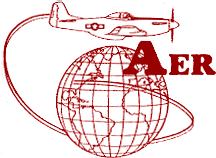|
But this month (December 2004) there are at least two sad aerobatic accidents to report. Both occured at airshows. Both pilots were experienced and, at least in aerobatic circles, fairly well known. The NTSB Preliminary Reports are given in their enirety.
Also, the NTSB has released its Final Report on American Airlines Flight 587, an Airbus A300-605R (N14053) that lost its vertical stabilizer and crashed in Queens, N.Y., on November 12, 2001, just after the World Trade Center attacks, prompting fears of a follow-up attack by terrorists.
Sean DeRosier was a well-known airshow pilot whose home air field was Nut Tree Airport in Vacaville, CA. His plane was a customized DR-107, based on Dan Rihn’s “One Design,” a home-built aircraft popular among aerobatic competitors and enthusiasts.
A crash earlier in the month at a Santa Fe, New Mexico airshow took the life of Richard Bobbitt of Parker, Colo., who was flying a Sukhoi SU-29 when he falied to recover from a spin that developed out of a tail slide.
Our hearts go out to both pilot’s family and friends.
NTSB Identification: LAX05LA007
14 CFR Part 91: General Aviation
Accident occurred Friday, October 15, 2004 in San Diego, CA
Aircraft: DeRosier DR-107, registration: N31SH
Injuries: 1 Fatal.
This is preliminary information, subject to change, and may contain errors. Any errors in this report will be corrected when the final report has been completed.
On October 15, 2004, about 1015 Pacific daylight time, a DeRosier DR-107 experimental airplane, N31SH, impacted terrain while performing aerobatics at the Miramar Marine Corps Air Station, San Diego, California. The pilot/owner was operating the airplane under the provisions of 14 CFR Part 91. The commercial pilot, the sole occupant, sustained fatal injuries; the airplane sustained substantial damage. The local aerobatic flight departed from Miramar about 1000. Visual meteorological conditions prevailed, and a flight plan had not been filed.
In a telephone conversation with a National Transportation Safety Board investigator, a Federal Aviation Administration (FAA) inspector stated that the pilot was scheduled to perform aerobatic maneuvers for an air show. About 15 minutes into the flight, the pilot began a rolling maneuver that the airplane was to pull out of and continue parallel to the ground. The airplane never pulled out of the downward flight path and impacted terrain.
* * *
NTSB Identification: DEN05FA002
14 CFR Part 91: General Aviation
Accident occurred Saturday, October 02, 2004 in Santa Fe, NM
Aircraft: Sukhoi SU-29, registration: N92CG
Injuries: 1 Fatal.
This is preliminary information, subject to change, and may contain errors. Any errors in this report will be corrected when the final report has been completed.
On October 2, 2004, at 1327 mountain daylight time, a Sukhoi, SU-29 aerobatic stunt airplane, N92CG, piloted by an airline transport pilot, was destroyed when it impacted terrain 500 feet west of runway 20 at the Santa Fe Municipal Airport (SAF), Santa Fe, New Mexico. A post crash fire ensued. Visual meteorological conditions prevailed at the time of the accident. The aerobatic flight was being conducted under the provisions of Title 14 CFR Part 91 without a flight plan. The pilot was fatally injured. The local flight was the second performance in the 2004 Santa Fe Air Show. The flight originated at 1255.
A Federal Aviation Administration (FAA) inspector spoke to the pilot before he took off. The inspector reviewed his certificates and his records. The inspector said the pilot looked fine, was talking, upbeat, and very cooperative. "He was willing to show us anything (certificates, records) we wanted to see."
The inspector was in the SAF Air Traffic Control Tower when the air show began. The inspector said that the airplane took off early and held outside the show area for a T-33 jet, which was the show's first performance. The inspector said the pilot then went into his routine. He said the airplane was really high, approximately 1,500 feet above ground level, when he entered his second maneuver, an "inverted spin." He said, "The pilot attempted to recover but didn't make it. The airplane struck flat in an upright, nose down attitude and was engulfed in a fireball."
A witness, also one of the air show's performers, said the pilot was performing a torque roll. In this maneuver, the airplane pulls up into a vertical climb at full throttle. As the airplane runs out of airspeed, torque from the engine and propeller turns the airplane. The airplane then falls off one direction or the other, nose down, and the pilot flies the airplane out of the dive. The witness said he saw the airplane come out the bottom of the smoke and enter an inverted flat spin. The witness said he saw the airplane make three revolutions. The witness said he thought the pilot had gone too far. "He came off the throttle, the rotation stopped, then the airplane yawed. I heard the engine come in. The airplane came around in a positive attitude. He was getting low. He was upright in a spin. He went to full power. He made a turn and a half and then hit [the ground]."
|
